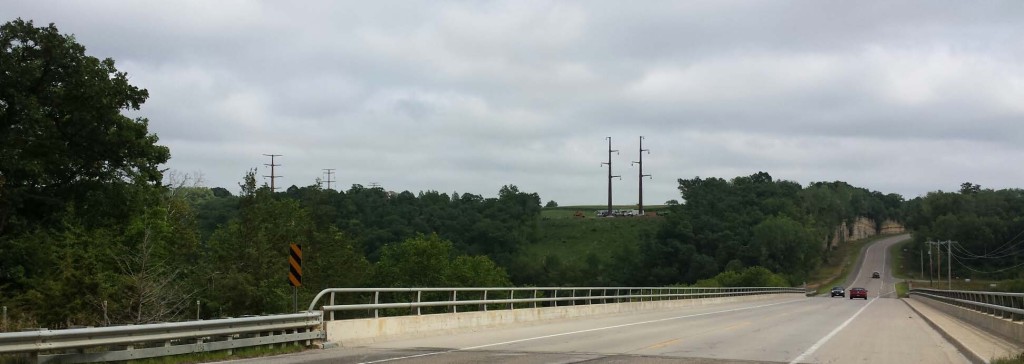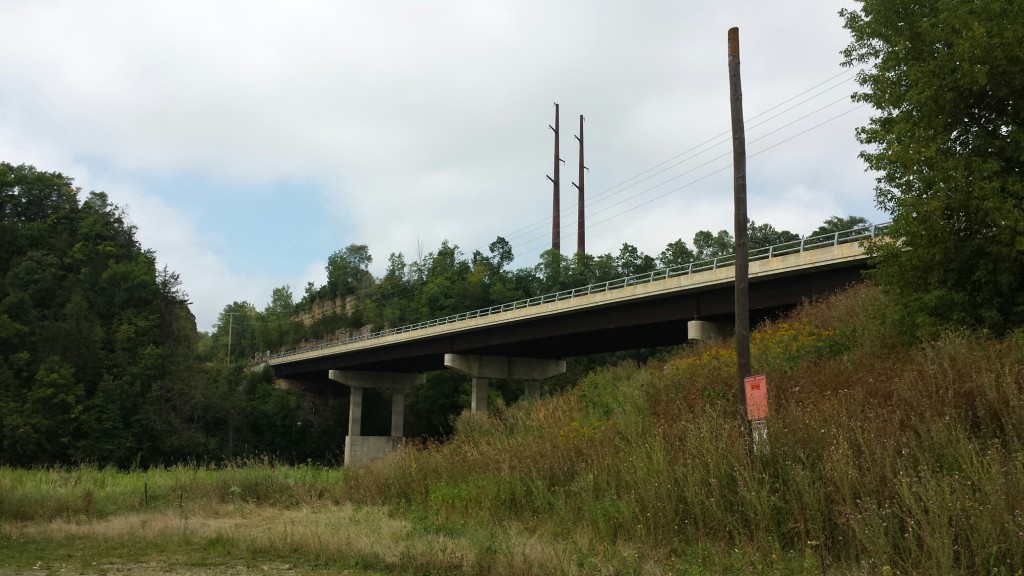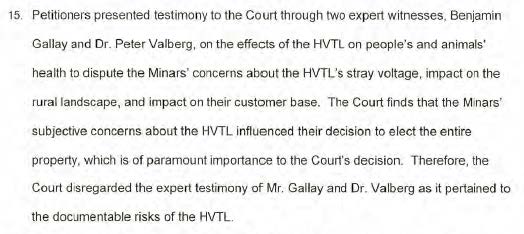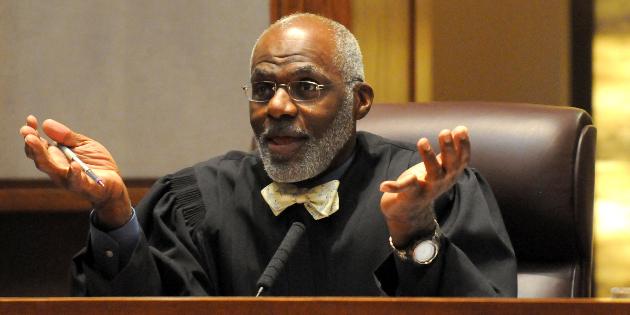Washington State & Buy the Farm
February 18th, 2015
OH HAPPY DAY!!!!
Washington State is working on “Buy the Farm,” based on Minnesota’s law, which is an option for landowners facing condemnation for a transmission line to force the utility to buy them out, to “Buy the Farm.” A bill was introduced last Monday in the Washington State House:
House Bill 2047
It’s been referred to House Judiciary — here’s the page for status of bills:
Is this exciting or what?!?! Each state where transmission projects are proposed should get going and enact “Buy the Farm.” I’ve had a request to pass this around far and wide, so here goes!
Minnesota’s “Buy the Farm” law is, so far, the only one in the nation that provides and option for landowners to force the utility to buy them out, rather than just condemn a small easement. This allows landowners to get out from under a transmission line. Here’s Minnesota’s Buy the Farm:
Minn. Stat. 216E.12, Subd. 4. Contiguous land.
+++++++++++++++++
Some Buy the Farm background:
(from No CapX 2020)
Here are some photos I took yesterday of the CapX 2020 transmission project being constructed at White Bridge Rd. over the Zumbro River — UGLY UGLY UGLY, it’s ugly wherever it goes.
From KAAL-TV, filmed yesterday near Pine Island and Oronoco:
A long-time energy activist recently called “Buy the Farm,” Minn. Stat. 216E.12, Subd. 4, MY statute. And in a way, it is… For at least 15 years now, since the Chisago and Arrowhead Project, its been a constant mantra. I’ve been raising “Buy the Farm” in the administrative dockets, the courts and the legislature. If I had a dollar for every “Buy the Farm” flyer I’ve handed out at transmission line meetings and hearings, every mile driven across Minnesota, every hour greeting attendees, every legislator hounded, I’d never have to work again.
In 1999, World Organization for Landowner Freedom went to the Appellate Court after Minnesota Power filed for an exemption of its Arrowhead Transmission Project at the Environmental Quality Board and the exemption was granted by the EQB. Minnesota Power requested this exemption because the line was so short it was exempted from a Certificate of Need, so what the heck, let’s try to get it exempted from Power Plant Siting Act’s Routing requirements as well… and they did. One “unintended consequence” was that because it was exempted from the Power Plant Siting Act, landowners affected by the project were not able to elect “Buy the Farm” because it is part of the Power Plant Siting Act. But of course, I don’t think that was “unintended” at all.
What did the court say to our argument that the landowners didn’t receive notice that exemption would mean they couldn’t elect Buy the Farm? Well, can you spell “raspberries?”
Due process challenge to notice to landowners
Ja, tell that to the landowners under the 345 kV line… (and btw, sufficiency of notice WAS raised).
In 2001, when the legislature changed the definition of “High Voltage Transmission Line” to a transmission over 100 kV, utilities realized it would mean lines such as the SE Metro line or the Chisago Transmission Project would be affected, so they went to the legislature to get the threshold for Buy the Farm raised to 200 kV. There was strong resistance, we stormed the Capitol, showed up and testified, but they won, lined up their toady legislators and got it through. The result? Landowners under all of these 69 kV “upgrades” to 115 kV and 161 kV are not able to elect the “Buy the Farm” option, despite it now being categorized as “High Voltage Transmission.”
Then the utilities began their transmission build-out, and massive it is. Having to comply with “Buy the Farm” would greatly increase their construction costs, though they are required to sell BTF land acquisitions within a few years. And over a decade later, in the St. Cloud area, with the first of the CapX 2020 projects to wind through the courts for condemnation, Xcel fought kicking and screaming against landowner elections of Buy the Farm and demands for relocation compensation. Jerry Von Korff led the charge for landowners and No CapX 2020 and United Citizens Action Network filed an Amicus brief. Xcel lost:
Buy the Farm — A Win For The Home Team!
That decision, for the landowners fighting for their right to elect Buy the Farm and for an award of relocation expenses, was a big slap upside the head for those utilities trying to limit landowner compensation — Xcel fought it through the Appellate Court and all the way to the Minnesota Supreme Court — losers again:
Minnesota Supreme Court Opinion – Court File A11-1116
Did they learn? Naaaaaaaaaah… and here they go again, with another great win for landowners in the District Court:
Minar Order_Buy the Farm
This decision establishes yet another point on the “Buy the Farm” line showing that landowners do have rights, and can elect the Buy the Farm option.
What’s particularly important in this case is that the judge recognized that it’s NOT about the substantive issues of EMF, that causation is not at issue in an eminent domain condemnation proceeding (anymore than it is in an administrative permitting proceeding, but see Power Line Task Force v. Public Utilities Commission (2001) for the appellate view on EMF and the PUC’s responsibility for safe electricity), that experts are utterly irrelevant and should be disregarded and really, shouldn’t have been admitted — that framing by Xcel is distraction:
If only the Public Utilities Commission and the Administrative Law Judges working these cases would get that message.
The trend continues… Buy the Farm is the law in the state of Minnesota. Utilities, get used to it. If you want to take land, pony up.
Will Xcel challenge this District Court decision? We shall see, and if they do, we’ll have Amicus “pen” in hand to again join the fracas in support of landowners.
7849 Rulemaking — deja vu all over again
July 12th, 2013
This post is dedicated to Kristen Eide-Tollefson, a fierce advocate for public participation who likely strikes terror into the heart of every bureaucrat trying to keep the public out.
To have come full circle again, AGAIN, with the same old arguments from utilities and agencies charged with protecting the ratepayers, public interest, and environment, it’s getting old… as I am… and tired of spending so much time countering utility self-interest and agency pandering trying to preserve a modicum of equity in review of their proposals.
 Photo from Daily Planet: Save Dinkytown effort escalates in Minneapolis as Book House and the Podium get ready to say goodbye
Photo from Daily Planet: Save Dinkytown effort escalates in Minneapolis as Book House and the Podium get ready to say goodbye
Having been through Minnesota’s statutory changes to the Power Plant Siting Act, and the subsequent rulemaking, remember, this was after NSP’s legislatively mandated attempt to site nuclear waste in Florence Township and post Arrowhead-Weston and Chisago Transmission Project in an effort to keep that sort of mess from happening again, I’m more than a little skeptical of the agency (arm of the executive, don’t forget) and utility agendas. Add to it the inexplicable draft proposals from Office of Administrative Hearings on the 1400-1405 rules used in utility and other contested case proceedings (oh, and I guess I’d better check to see what they did to rulemaking!?!), it’s a big job to think up the dreadful scenarios that could result from their proposals and try to prevent it.
So there I am, cleaning out the office in one house, trying to separate the wheat from the diamonds, and I found this gem:
This was an email sent March 16, 2001, over 12 years ago…
Experience shows that when timelines or processes are foreshortened, or need review &/or siting processes are circumvented, the public grows reactive. Persistent attempts to evade full review by state and public bodies create increased, and increasingly organized resistance, to utility strategies. To attempt to “streamline” or proceed with projects without due public process invites only grassroots revolt & lawsuits. Such “streamlining” may give one side or another momentary advantage (maybe just enough to get those bulk power transmission projects into place), but it will not bring the two “sides” into better working relationship.
The public rarely goes into a siting or routing situation distrusting the utility. Controversy is created time and time again by the utility itself in”
1) the disregard applications show for the qualities and values of the communities; and
2) inadequate information given to the public; and
3) lack of candor/disclosure of the real purposes or goals of a project.
Deja vu all over again… The public has spoken, over and over and over and over and over and over, in the individual project dockets and for close to two decades at the Power Plant Siting Act Annual Hearing. Back to Kristen’s missive:
Among other things, the public advised:
1) more careful screening of applications up front.
2) reviving the ongoing public advisory task force; and
3) reactivating the “planning” component with public participation in standards and criteria development (Minn. Stat. 116C.55, since deleted). To be involved with planning features up front could alleviate tensions and create more mutual accountability among all parties; and
4) greater consideration of resource discrepancies between proposers and affected public/communities.
As proof of the continuity of public response, we found in reviewing the record of the power plant siting advisory committees from the early 80s that our advisories, almost 20 years later, differed very little from theirs.
Let’s make it 30 years now… Yet what we’ve seen since these words were written in 2001 is something else entirely, for example, the removal of planning from the state, to MAPP in St. Paul, to MISO in Indiana, further away from the project area, and further away from the people, geographically and in our ability to participate. Planning has become more and more remote. Citizens complaining are told to participate at MISO — right, yeah sure, as if any participation there has any impact:
Back to Kristen’s missive:
From a public perspective, these two values are primary. Private utility investments, fair profits and returns are part of the equation. But infrastructure development for distant industrial markets for competitive advantage of private corporate interests is another matter. The development of this competitive infrastructure depends above all else, according to the January issue of Electricity Journal, upon transmission. This is the line that the public has drawn.
We do not want our lands, air and waters to become a generating and transmission ‘factory’ for industrial centers. We do not want our affordable energy to be traded, sold or transferred to other states, and to be blamed for ‘reliability’ problems when it is.
To fail to provide due process for the analysis of the implications and impacts of such proposals is to fail the public purpose of law and policy. Please consider these implications in all of your deliberations.
Hear that, Public Utilities Commission?
Buy the Farm — A Win For The Home Team!
May 29th, 2013
Today we had a rulemaking Advisory Committee meeting about Public Utilities Commission rules for Certificate of Need proceedings. More on that later, because at 10:00 a.m. the Minnesota Supreme Court decision on Buy the Farm was released (Buy the Farm, Minn. Stat. 216B.12, Subd. 4, is a statutory provision where landowners can force a utility to condemn their whole parcel, rather than just a narrow easement and let them get out from living under a transmission line), and oh what a decision. Kudos to Jerry Von Korff, who was at the rulemaking meeting, and his cohort Igor Lenzner, also Michael Rajkowski and Sarah Jewell, the attorneys who brought the appeal, plus Rod Krass/Kirk Schnitker and yours truly on Amicus. It was a win for landowners, homeowners, farmers, business owners, for everyone who has transmission condemnation/eminent domain cases pending, this one’s for YOU!
It really doesn’t get much better than this.
Bottom line on minimum compensation? Landowners are entitled to minimum compensation:
Appellants who elected to require utilities to condemn their entire properties in fee pursuant to Minn. Stat. § 216E.12 (2012) are entitled to minimum compensation under Minn. Stat. § 117.187 (2012) as owners who “must relocate” because on the date of the taking, the utilities took title to and possession of appellants’ entire properties.
… and …
Accordingly, we must determine whether appellants were required to relocate at the time their properties were taken. Because NSP initiated quick-take condemnation proceedings, the time of the takings with respect to appellants’ properties was when title to and possession of the property passed to NSP. See Moorhead Econ. Dev. Auth., 789 N.W.2d at 874 (explaining that “the date of the taking” in a quick-take condemnation proceeding is when “the transfer of title and possession” occurs, which is “well before the commissioners file their award”). It is undisputed that by the time title to and possession of appellants’ properties passed to NSP, appellants had made their elections under Minn. Stat. § 216E.12, subd. 4, which by operation of the statute, automatically converted the easements sought into fee takings. See Minn. Stat. § 216E.12, subd. 4 (explaining that at the time the property owner makes an election, “the easement interest over and adjacent to the lands designated by the owner to be acquired in fee . . . shall automatically be converted into a fee taking”). It follows that, at the time of the takings, NSP took title to and possession of appellants’ entire properties in fee. Therefore, we conclude that appellants were owners under Minn. Stat. § 117.187 who, at the time the takings occurred, “must relocate.” Accordingly, they are entitled to minimum compensation.
Bottom line on relocation benefits? Landowners are entitled to relocation benefits:
Because appellants are “displaced persons” under federal law, they are entitled to relocation assistance under Minn. Stat. §§ 117.50-.56 (2012).
… and…
Because appellants are required to relocate permanently, they do not fall within the exemption in 49 C.F.R. § 24.2(a)(9)(ii)(D). Therefore, because we conclude that appellants satisfy the definition of “displaced persons” under 42 U.S.C. § 4601(6)(A)(i)(I) and do not fall within any exemptions to that definition, we hold that appellants are entitled to relocation assistance under Minn. Stat. §§ 117.50-.56.
The decision was written by Justice Alan Page (photo from StarTribune www.startribune.com):
Yes, when he’s not wearing a football uniform, he’s the guy who is ALWAYS seen wearing one of his many classic “Jacobsen” bow ties, standing up for the public interest and the people of Minnesota. For him to be in the spot where he is, to do the work he’s doing, a long strange trip for a football player (sort of like it was for a truckdriver, eh?), with some good mentoring along the way.

This decision is something I’ve been working for, and toward, since I first got involved with the Chisago Transmission Project so long ago, and folks, that’s 17 years now…
Now and then, some event rates an “OH HAPPY DAY!” and this is the best of all, so this time from Aretha… OH HAPPY DAY!!!
From the St. Cloud Times:
The decision by the state’s highest court overturns a Court of Appeals decision and affirms the ruling by Stearns County District Court Judge Frank Kundrat that had been overturned by the Court of Appeals.
The Supreme Court ruling hinged on whether property owners who chose to require CapX to condemn their property would receive that compensation or whether those property owners chose to move from their property and therefore aren’t entitled to the compensation.
Read the rest of this entry »
Buy the Farm bolstered, at long last
May 22nd, 2013
WOW, what a long strange trip this has been. I’ve been on this since Chisago I (1996) and Arrowhead:
Arrowhead was exempted, and hence Buy the Farm doesn’t apply, so that went to the Appellate Court, which tossed it out. And the 2001 statutory changes, which defined “high voltage transmission lines” as anything over 100 kV, meaning Buy the Farm would apply to 115 kV lines like SE Metro, and Chisago, but nooooo, can’t have that, so Sen. Metzen then amended in 2002 so that it only applies to lines 200 kV or over. GRRRRRRRRRRRR.
Here’s the update in the Belle Plaine Herald (why is there nothing whatsoever in the STrib?). GRE’s Randy Fordice claims it’s vaguely worded, but I think it’s pretty specific:
All rights and protections provided to an owner under chapter 117 apply to acquisition of land or an interest in land under this section.
DOH! Vague my ass…
|
|
|
Mayor Egan to resign? Sand mining bill introduced!
February 23rd, 2013
A PICTURE IS WORTH A THOUSAND WORDS!!!
YES!!! Making progress today on two fronts in the frac sand world here in Red Wing and in Goodhue County!! First, Mayor Egan has announced he WILL resign, but he hasn’t yet. Second, there’s a draft bill circulating that regulates sand mining and which mandates an EIS, and I’ll post a more detailed review of that soon.
But the problem here is that Dennis Egan shouldn’t wait for a month to resign — Egan should resign NOW! Way down at the bottom of this is a good editorial from Richard Johnson, a former County Attorney, who was ejected from the Council meeting. He was outraged at the Council’s lack of a backbone, understandably! (I missed the meeting, couldn’t be there, was on the train almost to L.A. then, and trains have to be booked 6 months in advance to get a decent price.) The week of hasty communications before the Council meeting seems to have been worthwhile, seems to have been heard. It took a while, though, for them to get wound up. There are a lot of us here in town utterly disgusted by Egan’s lack of judgment and is inability to see that it’s a problem. Seems that the Council and us voters pushed hard enough to make it impossible for him to continue. His statements are still statements of denial, more evidence of the depth of his cluelessness (I’m struggling for words here!).
Let’s hope this resignation plan isn’t an April Fools gag. Red Wing City Council, GET IT IN WRITING!
The story in the paper is more extensive than the online version, CLICK HERE FOR PDF OF STORY IN REPUBLICAN EAGLE, and here’s what’s on-line:
Egan will leave mayoral post
Meanwhile, there’s a frac sand mining bill in the works, here’s the draft as I received it:
There are some issues with this, particularly regarding local control. This bill doesn’t do nearly enough to preserve the rights of local governments to do set their own more stringent regulations, it allows it but needs to clearly state that the local more stringent regulations are controlling — if not we’re in the same mess we wound up in on the Goodhue Wind project. Also, it sets a one year limit on the EIS preparation time, and from the transmission projects I’ve worked on, it may well take more than that. It does not include Chisago and Washington Counties… But this is a draft, there’s plenty of time to work on it. More on that in a bit.
And more good news — soon to be ousted Mayor Egan is in the Rochester Post Bulletin and the STrib too:





